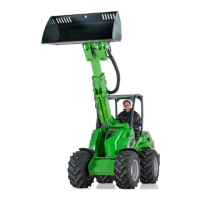
Do you have a question about the Avant Tecno Oy Avant 850 and is the answer not in the manual?
| Brand | Avant Tecno Oy |
|---|---|
| Model | Avant 850 |
| Category | Front End Loaders |
| Language | English |
Lists fundamental safety rules for operating the loader and working safely.
Details critical hazards like falling loads, crushing, hydraulic pressure, and falling objects.
Covers risks of crushing, safety device integrity, pinching hazards, and seat belt usage.
Addresses suffocation, hot exhaust gas, and fire/explosion risks with necessary precautions.
Provides guidance on safely managing heavy loads to prevent tipping and ensure stability.
Explains overturning risks from frame articulation/movements and the load sensor system.
Details safety procedures for operating on slopes, uneven terrain, and near excavations to prevent tipping.
Specifies required PPE like gloves, boots, glasses, and safety clothing for operator protection.
Explains the function of ROPS/FOPS and the importance of keeping them installed and undamaged.
Covers FOPS limitations, modification warnings, and electrocution risks near powerlines.
Outlines hazards of digging, including buried cables and excavation collapse, and advises contacting authorities.
Details safe procedures for handling batteries, preventing short-circuits, acid exposure, and explosions.
Covers fire hazards from debris/battery and the importance of the battery disconnect switch.
Specifies correct engine oil types, viscosity, and fuel standards required for optimal performance.
Explains ROC, its calculation, and the conditions under which ROC tables are valid.
Details the operation of the multi-function lever for boom, bucket movements, and auxiliary hydraulics.
Explains controls for the telescopic boom and the 8-function joystick for attachments.
Covers electric control of the telescopic boom, hand throttle, and the parking brake switch.
Emphasizes safety first, maintaining control, and risk of collision during operation.
Details pre-start checks, safety precautions, and potential hazards during engine starting.
Explains the ignition key positions and the step-by-step procedure for starting the engine.
Outlines the safe procedure for stopping the engine and addresses risks to bystanders from attachments.
Explains the hydrostatic drive system, use of drive pedals, and risks associated with driving and turning.
Explains loader steering, risks of tipping during turns, and maintaining safe posture within the frame.
Provides critical instructions on what to do if the loader tips over, emphasizing immediate shutdown and safety.
Guides on correct material handling, attachment use, and safe practices for carrying heavy loads to prevent tipping.
Outlines requirements for attachments, emphasizing compatibility, intended use, and safety.
Provides step-by-step instructions for securely coupling attachments to the loader's quick coupling plate.
Details the hydraulic attachment coupling system, its operation, and safety for preventing attachment drops.
Explains how to control auxiliary hydraulics for attachments, including lever operation and safety risks.
Provides essential safety procedures and precautions to follow before and during any maintenance or service operation.
Details risks of high-pressure fluid injection and leaking hydraulic oil, emphasizing safe handling and inspection.
Covers various maintenance risks including falling loads, burns from hot parts/coolant, moving parts, and hydraulic oil bursts.
Outlines the importance of regular servicing and presents daily, periodic, and first service schedules.
Provides a checklist for daily and weekly inspections to ensure the loader is in safe working condition.
Addresses common engine problems like failure to crank, starting issues, and overheating, providing possible causes and remedies.
Covers issues with attachment hoses, hydraulic system overheating, and the loader not moving after brake release.